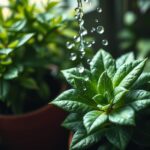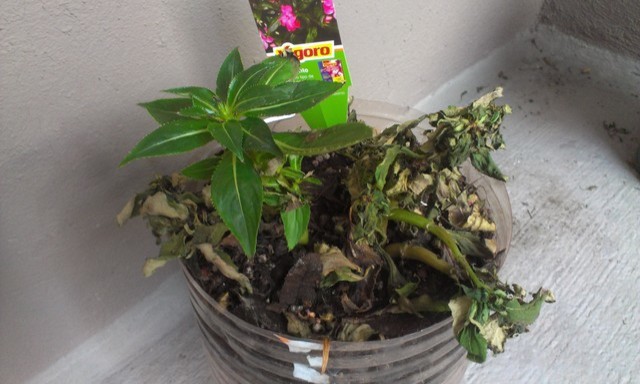What Do Overwatered Impatiens Look Like? Signs, Symptoms, and Solutions

Overwatering is a common issue among gardeners, especially with plants like impatiens that thrive in moisture. However, too much water can lead to detrimental effects, manifesting through various signs and symptoms. Recognizing these indicators is crucial for maintaining the health of your impatiens and ensuring they flourish throughout the growing season. In this article, we will explore what overwatered impatiens look like, including visual cues and growth changes, as well as effective solutions to rectify the problem. By understanding these aspects, you can help your plants regain their vitality and restore their vibrant beauty.
What Do Overwatered Impatiens Look Like?
When Impatiens are overwatered, they can exhibit several clear and noticeable symptoms, primarily characterized by their foliage and overall plant health. The leaves of overwatered Impatiens often appear yellow and can develop a mushy texture due to excess water saturation in the soil, which leads to poor oxygen availability for the roots. As a result, the plants might show signs of wilting even though the soil is moist, and the stems may appear weak or droopy. In severe cases, the roots can begin to rot, which will cause the plant to survive less effectively, leading to stunted growth and a compromised ability to thrive.
Symptoms of Overwatering
Overwatered Impatiens display distinct symptoms such as yellowing leaves and stunted growth. The foliage may also become soft, showing a limp appearance due to excess moisture. If left unaddressed, the plants can develop further complications like root rot, which is indicated by a foul smell emanating from the soil.
Differences from Underwatering
While both overwatered and underwatered Impatiens can wilt, the key difference lies in the condition of the leaves. Overwatered plants often have yellow leaves that may fall off easily, whereas underwatered Impatiens tend to have crispy and brown leaf tips. Observing the color and texture can provide valuable hints for appropriate watering interventions.
Cultural Factors Contributing to Overwatering
A variety of cultural factors can lead to overwatering Impatiens, including the choice of soil, pot size, and weather conditions. For instance, heavy soils that retain moisture can prevent adequate drainage, resulting in waterlogged conditions. Additionally, placing the pots in areas with low sunlight and high humidity can exacerbate the issue, leading to an increased likelihood of overwatering.
Impact on Plant Health
Overwatering not only affects the appearance of Impatiens but also their overall health. A continuously saturated environment hampers root development and can lead to root rot, severely limiting the plant's ability to absorb essential nutrients and water. This can result in diminished growth, reduced flowering, and, in worst-case scenarios, the plant's death.
Corrective Measures
To remedy the situation of overwatered Impatiens, immediate corrective actions must be taken. Allowing the soil to dry out partially before the next watering is essential, and ensuring that the pots have adequate drainage holes can help facilitate proper water flow. Adjusting the watering schedule based on environmental conditions and observing for signs of distress can prevent further degradation.
| Symptom | Description |
|---|---|
| Yellowing Leaves | Indicates excess moisture affecting leaf health. |
| Mushy Texture | Resulting from saturated soil conditions. |
| Wilting | Plants appear limp despite moist soil. |
| Root Rot | Leads to foul smell and inability to absorb nutrients. |
| Weak Stems | Indicates a compromised structural integrity. |
How do I know if I overwatered my impatiens?

To determine if you have overwatered your impatiens, you should look for several signs and symptoms that indicate excess water in the soil. Overwatering can lead to issues such as root rot, fungal infections, and poor plant health. Here are the key indicators:
Signs of Overwatered Impatiens
The most obvious signs of overwatering in impatiens can be spotted by examining the plant's leaves and overall appearance:
See also:
- Wilting leaves: Even when the soil is wet, the leaves may droop and appear lifeless.
- Yellowing leaves: The leaves may turn yellow, starting from the bottom and moving up, indicating stress from too much water.
- Brown leaf edges: The edges of the leaves may become brown and crispy due to nutrient deficiencies caused by poor drainage.
Root Health Assessment
Healthy roots are crucial for the overall well-being of your impatiens. Checking the root health can help you identify if overwatering has occurred:
- Soft or mushy roots: Healthy roots should be firm and white; mushy or brown roots indicate decay.
- Unpleasant odor: If the roots emit a foul smell, it may suggest root rot, a result of excessive moisture.
- Fungal growth: The presence of mold or fungal spores on the soil surface signals that the environment is too damp.
Soil Condition and Drainage
Examining the soil is essential in determining whether your impatiens are receiving too much water:
- Soil moisture level: If the soil remains soggy several days after watering, it indicates poor drainage and overwatering.
- Soil compaction: Over time, compacted soil retains more water; it should be loose and well-aerated.
- Water pooling: Observe if water pools on the surface instead of draining; this is a clear sign of overwatering.
Environmental Factors
Consider the external conditions that might contribute to overwatering in your impatiens:
- Humidity levels: High humidity can slow down evaporation, leading to waterlogged soil.
- Potted vs. ground planting: Potted plants may require different watering schedules compared to plants planted directly in the ground.
- Weather conditions: Extended periods of rain or high watering frequency can exacerbate the problem.
Preventive Measures for Overwatering
To avoid overwatering your impatiens, follow these preventive measures:
- Check the soil moisture regularly: Use a moisture meter or your finger to assess the moisture level before watering.
- Water less frequently: Allow the soil to dry out between watering, especially in cooler months.
- Improve drainage: Ensure that your pots have drainage holes and consider adding perlite or sand to the soil mix.
What happens if impatiens get too much water?

If impatiens get too much water, several detrimental effects can occur, affecting the plant's health and growth. Impatiens are known for their vibrant blooms and preference for consistently moist soil. However, overwatering can lead to a range of problems:
1. Root Rot: The most significant effect of excessive water is root rot, a fungal disease that thrives in overly wet conditions.
- Signs of root rot include:
- Leaves yellowing and wilting.
- Roots that appear brown or black instead of white.
- A foul smell coming from the soil.
2. Nutrient Deficiency: When the soil is saturated, the roots may struggle to absorb vital nutrients due to waterlogged conditions.
- Symptoms of nutrient deficiency manifest as:
- Pale leaves or poor color in blooms.
- Stunted growth and weak stems.
- Slow or halted flowering.
3. Fungal Infections: High moisture levels can encourage fungal diseases like downy mildew and powdery mildew.
- Indications of fungal infections include:
- White or gray powdery spots on leaves.
- Dark spots or blotches on foliage.
- Leaf drop in severe cases.
4. Poor Aeration: Overwatering leads to compacted soil, reducing oxygen availability for the roots.
- The consequences of poor aeration are:

- Weak root structure, making plants more susceptible to environmental stress.
- Increased likelihood of pests targeting the stressed plant.
- Difficulty in transplanting or dividing due to a compromised root system.
5. Wilting and Leaf Drop: Ironically, despite the abundance of water, overly wet impatiens can display signs of wilting as roots become damaged.
- Symptoms to watch out for include:
- Leaves curling or turning brown at the tips.
- Premature leaf drop, which impacts the plant's aesthetic appeal.
- General lack of vigor in the plant's appearance.
Which two symptoms are signs of overwatering?

Overwatering can lead to several issues for plants, and two common symptoms that indicate a plant is receiving too much water are yellowing leaves and root rot.
Yellowing Leaves
When plants are overwatered, the most noticeable symptom is often the yellowing of leaves. This occurs when the roots are deprived of oxygen due to excessive moisture. The plant struggles to uptake nutrients effectively, leading to chlorosis.
- Soil Saturation: The soil remains constantly wet, preventing oxygen from reaching the roots.
- Nutrient Deficiency: Essential nutrients become less available, causing the leaves to turn yellow.
- Lower Leaves First: Usually, the lower leaves will yellow first before affecting the rest of the plant.
Root Rot
Root rot is another significant symptom of overwatering. This condition occurs when roots sit in waterlogged soil, leading to fungal infections and decay. Affected roots lose their ability to absorb water and nutrients, which threatens the plant's overall health.
- Brown or Black Roots: Healthy roots are typically white; rotting roots will look brown or even black.
- Soft and Mushy Texture: Healthy roots are firm, while rot gives them a soggy, mushy feel.
- Foul Odor: A strong, unpleasant smell often accompanies root rot due to decomposition.
Wilting Despite Wet Soil
Overwatered plants can exhibit wilting even when the soil feels moist. This paradox occurs because the roots are not functioning properly due to a lack of oxygen, which prevents water uptake.
- Air Pockets Compromised: Excessive water fills air pockets in the soil, hindering root respiration.
- Stress Signals: The plant still exhibits stress through wilting as it cannot absorb water.
- Response to Environment: Conditions like high humidity can worsen wilting in overwatered plants.
Leaf Drop
Leaf drop is another indicator of overwatering. When a plant receives too much water, it may respond by shedding leaves to reduce stress.
- Excess Moisture Impact: High moisture levels can cause leaves to become heavy and fall off.
- Stress Mechanism: Dropping leaves is a survival tactic employed by plants to conserve energy.
- Progressive Downturn: Initially, older leaves may drop, but eventually, newer growth can be affected too.
Yellowing Leaf Tips
In some cases, the tips of the leaves may turn yellow as a sign of overwatering. This can indicate issues such as nutrient imbalances or root suffocation.
- Localized Stress: Yellow leaf tips suggest localized moisture stress at the root level.
- Mineral Lockout: Overwatering can lead to nutrients being locked out, especially potassium and nitrogen.
- Leaf Discoloration Pattern: A typical pattern is yellowing from the tips inward, which is distinct from other causes of yellowing.
Questions from Our Readers
What are the signs of overwatered impatiens?
Overwatered impatiens typically exhibit yellowing leaves, which may also appear droopy or limp. Additionally, the soil often remains soggy and waterlogged, leading to a lack of oxygen for the roots, which can cause root rot over time.
Can overwatered impatiens recover?
Yes, overwatered impatiens can recover if you take immediate action. Allowing the soil to dry out and ensuring proper drainage are crucial steps, along with pruning away any damaged foliage to encourage new growth.
See also:
How does overwatering affect impatiens growth?
Overwatering can stunt the growth of impatiens, as plants may become weak and susceptible to diseases. The excess water deprives the roots of oxygen, leading to poor nutrient uptake, which negatively impacts overall plant health and vitality.
What should I do if my impatiens are overwatered?
If your impatiens show signs of being overwatered, it’s essential to reduce their watering frequency and check the drainage of the pot or garden bed. You might also consider repotting the plants in fresh, dry soil to facilitate recovery.

If you want to read more articles like What Do Overwatered Impatiens Look Like? Signs, Symptoms, and Solutions, we recommend you check out our Plants category.
Leave a Reply
Related Articles